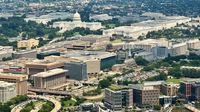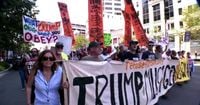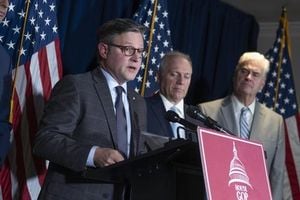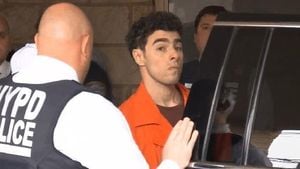On a sunny Saturday afternoon in Washington, D.C., the National Mall—a place usually buzzing with tourists, joggers, and families—became the scene of a dramatic intervention that underscored the city’s heightened security measures. According to the Defense Visual Information Distribution Service (DVIDS), D.C. Air National Guard Staff Sergeant Hector Amaya, a Security Forces Officer with the 113th Squadron, acted swiftly to halt an assault on a U.S. Park Police (USPP) officer who was directing traffic near one of the Mall’s busiest intersections.
The incident unfolded on August 16, 2025, just as crowds were flowing through the iconic expanse between the Lincoln Memorial and the U.S. Capitol. As the Park Police officer tried to keep the peace and order among the summer throngs, an individual allegedly attacked the officer in what witnesses described as a sudden and chaotic moment. Sgt. Amaya, who was on patrol as part of the National Guard’s ongoing presence in the area, responded immediately when he heard the officer’s call for help.
“I was the first one to catch up,” Amaya told DVIDS, recounting how he raced toward the commotion. His quick action helped subdue the alleged assailant and bring the situation under control before it could escalate further. The suspect was detained and promptly handed over to U.S. Park Police, who took charge of the investigation and custody.
The intervention came amid a broader effort by the National Guard to bolster security in Washington, D.C., particularly around high-profile sites such as the National Mall. This initiative, directed by President Donald Trump, has seen hundreds of additional National Guard members deployed across the city in a bid to crack down on crime and ensure public safety during a period of heightened tension and political activity.
The presence of uniformed National Guard members has become a familiar sight in recent weeks. Their patrols, often conducted in pairs or small groups, are meant to serve as both a deterrent to would-be offenders and a reassurance to residents and visitors alike. For many, the added security has brought a sense of comfort; for others, it’s a reminder of the city’s ongoing challenges with public safety and the complexities of policing in a democracy.
“National Guard members have been patrolling the National Mall and other parts of Washington, D.C. as part of President Donald Trump’s efforts to crack down on crime,” DVIDS reported. The effort is part of a broader national conversation about law enforcement, public safety, and the appropriate use of military personnel in domestic situations.
While the details of the assault—such as the motive and the extent of any injuries—were still being investigated at press time, the swift response by Sgt. Amaya drew praise from both his peers and the public. The U.S. Park Police have not yet released a statement regarding the condition of their officer or the identity of the alleged assailant, and 7News has reached out for further comment.
The National Mall, often called "America’s front yard," is no stranger to large-scale events, protests, or security incidents. Its open spaces and symbolic landmarks make it both a gathering place and a focal point for law enforcement. Over the years, the Mall has hosted everything from peaceful demonstrations to presidential inaugurations, each requiring a delicate balance between openness and security.
Saturday’s incident highlights just how quickly that balance can be tested. For Sgt. Amaya and his fellow National Guard members, the day’s events were a reminder of the unpredictability of their mission. Their patrols are designed not only to respond to emergencies but also to prevent them through visibility and engagement with the public.
“The person accused of assaulting the officer was detained and turned over to U.S. Park Police,” DVIDS confirmed. This efficient handoff between military and law enforcement personnel is part of a carefully coordinated approach to security, one that aims to respect both the rule of law and the rights of individuals involved.
The deployment of National Guard troops in D.C. has not been without controversy. Supporters argue that the increased presence deters crime and reassures a public weary of unrest and uncertainty. Critics, however, worry about the militarization of public spaces and the potential for overreach. As one local resident put it, “It’s comforting to see the Guard out here, but it’s also a little unnerving. You wonder what it says about where we are as a city and a country.”
President Trump’s directive to send more National Guard personnel to the nation’s capital was framed as a response to rising concerns about safety, especially in the wake of several high-profile incidents earlier this year. The move was also intended to support local law enforcement agencies stretched thin by the demands of policing a city that serves as both a local community and a global stage.
For the officers and guardsmen on the ground, the mission is clear—even if the challenges are complex. They are tasked with maintaining order, protecting lives, and upholding the values of public service, often under intense scrutiny and in rapidly changing circumstances. The events of August 16 serve as a powerful example of both the risks and rewards of that service.
As the city awaits more details from the U.S. Park Police about the outcome of their investigation, many are reflecting on the role of individuals like Sgt. Amaya. His actions, though rooted in training and duty, carried a personal sense of responsibility. “When you see someone in trouble, you act,” he said, echoing a sentiment shared by many first responders.
In the days ahead, questions will likely persist about the broader implications of military involvement in local policing and the best ways to ensure both safety and civil liberties. For now, though, the focus remains on the individuals who step forward in moments of crisis—whether they wear the uniform of a police officer or that of the National Guard.
Saturday’s events on the National Mall may soon fade from the headlines, but for those who witnessed them, they serve as a potent reminder of the everyday heroism that often goes unseen. As Sgt. Amaya and his colleagues continue their patrols, the city moves forward—ever watchful, ever hopeful, and always ready for the unexpected.





